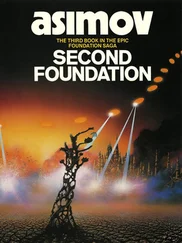“Yes, but that’s not enough. I need the distances of the other stars to within a percent or so. Their gravitational intensity in the neighborhood of the Forbidden World is so small that a slight error makes no perceptible difference. The sun about which the Forbidden World revolves—or might revolve—possesses an enormously intense gravitational field in the neighborhood of the Forbidden World and I must know its distance with perhaps a thousand times the accuracy of that of the other stars. The co-ordinates alone won’t do.”
“Then what do you do?”
“I measure the apparent separation of the Forbidden World—or, rather, its star—from three nearby stars which are so dim it takes considerable magnification to make them out at all. Presumably, those three are very far away. We then keep one of those three stars centered on the screen and Jump a tenth of a parsec in a direction at right angles to the line of vision to the Forbidden World. We can do that safely enough even without knowing distances to comparatively far-off stars.
“The reference star which is centered would still be centered after the Jump. The two other dim stars, if all three are truly very distant, do not change their positions measurably. The Forbidden World, however, is close enough to change its apparent position in parallactic shift. From the size of the shift, we can determine its distance. If I want to make doubly certain, I choose three other stars and try again.”
Pelorat said, “How long does all that take?”
“Not very long. The computer does the heavy work. I just tell it what to do. What really takes the time is that I have to study the results and make sure they look right and that my instructions aren’t at fault somehow. If I were one of those daredevils with utter faith in themselves and the computer, it could all be done in a few minutes.”
Pelorat said, “It’s really astonishing. Think how much the computer does for us.”
“I think of it all the time.”
“What would you do without it?”
“What would I do without a gravitic ship? What would I do without my astronautic training? What would I do without twenty thousand years of hyperspatial technology behind me? The fact is that I’m myself—here—now. Suppose we were to imagine ourselves twenty thousand additional years into the future. What technological marvels would we have to be grateful for? Or might it be that twenty thousand years hence humanity would not exist?”
“Scarcely that,” said Pelorat. “Scarcely not exist. Even if we don’t become part of Galaxia, we would still have psychohistory to guide us.”
Trevize turned in his chair, releasing his handhold on the computer. “Let it work out distances,” he said, “and let it check the matter a number of times. There’s no hurry.”
He looked quizzically at Pelorat, and said, “Psychohistory! You know, Janov, twice that subject came up on Comporellon, and twice it was described as a superstition. I said so once, and then Deniador said it also. After all, how can you define psychohistory but as a superstition of the Foundation? Isn’t it a belief without proof or evidence? What do you think, Janov? It’s more your field than mine.”
Pelorat said, “Why do you say there’s no evidence, Golan? The simulacrum of Hari Seldon has appeared in the Time Vault many times and has discussed events as they happened. He could not have known what those events would be, in his time, had he not been able to predict them psychohistorically.”
Trevize nodded. “That sounds impressive. He was wrong about the Mule, but even allowing for that, it’s impressive. Still, it has an uncomfortable magical feel to it. Any conjurer can do tricks.”
“No conjurer could predict centuries into the future.”
“No conjurer could really do what he makes you think he does.”
“Come, Golan. I can’t think of any trick that would allow me to predict what will happen five centuries from now.”
“Nor can you think of a trick that will allow a conjurer to read the contents of a message hidden in a pseudo-tesseract on an unmanned orbiting satellite. Just the same, I’ve seen a conjurer do it. Has it ever occurred to you that the Time Capsule, along with the Hari Seldon simulacrum, may be rigged by the government?”
Pelorat looked as though he were revolted by the suggestion. “They wouldn’t do that.”
Trevize made a scornful sound.
Pelorat said, “And they’d be caught if they tried.”
“I’m not at all sure of that. The point is, though, that we don’t know how psychohistory works at all.”
“I don’t know how that computer works, but I know it works.”
“That’s because others know how it works. How would it be if no one knew how it worked? Then, if it stopped working for any reason, we would be helpless to do anything about it. And if psychohistory suddenly stopped working—”
“The Second Foundationers know the workings of psychohistory.”
“How do you know that, Janov?”
“So it is said.”
“Anything can be said. —Ah, we have the distance of the Forbidden World’s star, and, I hope, very accurately. Let’s consider the figures.”
He stared at them for a long time, his lips moving occasionally, as though he were doing some rough calculations in his head. Finally, he said, without lifting his eyes, “What’s Bliss doing?”
“Sleeping, old chap,” said Pelorat. Then, defensively, “She needs sleep, Golan. Maintaining herself as part of Gaia across hyperspace is energy-consuming.”
“I suppose so,” said Trevize, and turned back to the computer. He placed his hands on the desk and muttered, “I’ll let it go in several Jumps and have it recheck each time.” Then he withdrew them again and said, “I’m serious, Janov. What do you know about psychohistory?”
Pelorat looked taken aback. “Nothing. Being a historian, which I am, after a fashion, is worlds different from being a psychohistorian. —Of course, I know the two fundamental basics of psychohistory, but everyone knows that.”
“Even I do. The first requirement is that the number of human beings involved must be large enough to make statistical treatment valid. But how large is ‘large enough’?”
Pelorat said, “The latest estimate of the Galactic population is something like ten quadrillion, and that’s probably an underestimate. Surely, that’s large enough.”
“How do you know?”
“Because psychohistory does work, Golan. No matter how you chop logic, it does work.”
“And the second requirement,” said Trevize, “is that human beings not be aware of psychohistory, so that the knowledge does not skew their reactions. —But they are aware of psychohistory.”
“Only of its bare existence, old chap. That’s not what counts. The second requirement is that human beings not be aware of the predictions of psychohistory and that they are not—except that the Second Foundationers are supposed to be aware of them, but they’re a special case.”
“And upon those two requirements alone, the science of psychohistory has been developed. That’s hard to believe.”
“Not out of those two requirements alone ,” said Pelorat. “There are advanced mathematics and elaborate statistical methods. The story is—if you want tradition—that Hari Seldon devised psychohistory by modeling it upon the kinetic theory of gases. Each atom or molecule in a gas moves randomly so that we can’t know the position or velocity of any one of them. Nevertheless, using statistics, we can work out the rules governing their overall behavior with great precision. In the same way, Seldon intended to work out the overall behavior of human societies even though the solutions would not apply to the behavior of individual human beings.”
Читать дальше












